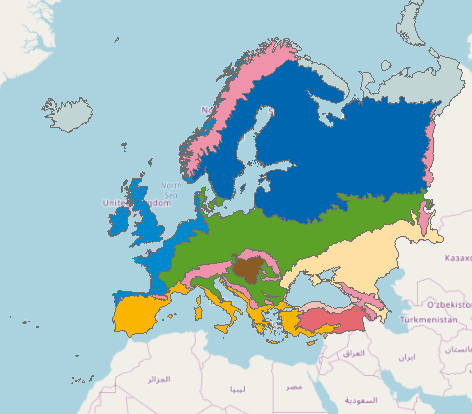biogeography
Type of resources
Available actions
Topics
INSPIRE themes
Keywords
Contact for the resource
Provided by
Years
Formats
Representation types
Update frequencies
status
Scale
Resolution
-

As a permanent service of Eurostat, GISCO: promotes and stimulates the use of GIS within the European Statistical System and the Commission; manages and disseminates the Geographical reference database of the Commission; acts as a reference centre concerning GIS; promotes geo-referencing of statistics and collaboration between national statistical institutes and mapping agencies; pursues and ensures standardisation and harmonisation in the exchange of Geographic Information; co-leads the INSPIRE initiative on the introduction of a European Spatial Data Infrastructure. Within the framework of the GISCO project, an extensive geo-referenced database has been developed. One of the main topics of the GISCO mandate is to extend, maintain and update this database. List of data sets offered by GISCO per ISO 19115 topic category (short name in []): a) Farming: farm accountancy data network [FADN] b) Biota: Natural Vegetation [VEGT], Biogeographical Zones [BIOG], Biotopes [BIOT] c) Boundaries: Territorial Units for Statistics (NUTS + Statistical Regions) [NUTS], Communes [COMM], Subcommunes [SCOM], Administrative regions [ADRG], Countries [CNTR] d) Climatology / Meteorology / Atmosphere: Climate [CLIM] e) Economy: Fishing Areas [FISH] f) Elevation: Digital Elevation Model [DEM], Bathimetry [BATH] g) Environment: Land Quality [LNQU], Designated Areas [DSIG] h) Geo-scientific information: Soil Erosion Risk [SOER], Geology Geomorphology ErosionTrend [ERTR], Soil [SOIL], Sediments Discharges [SDDS], Coastal Erosion [COER] i) Imagery/Base maps/Earth cover: Land Cover [LCOV] j) Inland waters: Water Patterns [WTPT], Lakes [LAKE], Watersheds [WTSH] k) Locations: Geographical Grid [GGGR], LUCAS [LUCA], Settlements [STTL], Gazetteer [GAZZ] l) Oceans: Coastline boundaries [COAS], Sea Level rise [SELV] m) Planning/Cadastre: Inter Regional [IREG], Leader Zones [LEAD], Less Favoured Areas [LFAV], National Support [NTSU], Structural Funds Zones [STFU], Urban Audit [URAU] n) Society: Population [POPU], Degree of urbanisation [DGUR] o) Transportation: Airports [AIRP], Ferry links [FERR], Ports [PORT], Road infrastructure [ROAD], Railway infrastructure [RAIL] p) Utilities/Communication: Nuclear Power [NUPW], Energy Production [ENPR], Energy Transport [ENTR] Further details can be found in gisco_naming_conventions_20090831.pdf
-

This dataset is based on the Environmental Stratification of Europe (EnS) dataset from the University of Edinburgh, a statistically derived land classification which provides a novel global spatial framework for the integration and analysis of ecological and environmental data (Metzger, Marc J. 2018). It provides a robust spatial analytical framework for the aggregation of local observations, identification of gaps in current monitoring efforts and systematic design of complementary and new monitoring and research. The version 8 of the source EnS dataset, used for the creation of this dataset, distinguishes 84 strata that are relatively homogeneous in environmental conditions and can be aggregated into 13 environmental zones: • Alpine North (ALN) • Boreal (BOR) • Nemoral (NEM) • Atlantic North (ATN) • Alpine South (ALS) • Continental (CON) • Atlantic Central (ATC) • Pannonian (PAN) • Lusitanian (LUS) • Anatolian (ANA) • Mediterranean Mountains (MDM) • Mediterranean North (MDN) • Mediterranean South (MDS) The original dataset (vector format, 1 km spatial resolution) has been rasterised into pixel size of 100m to align with Corine Land Cover. Its spatial coverage has been extended as follows: • Turkey is covered only partially in the original dataset. Missing parts are supplemented by a comparable national dataset provided by the Ministry of Environment and Forestry of Turkey. • The dataset is extended along the coastline to fully cover the spatial extent of CORINE Land Cover. • Canary Islands, Madeira archipelago and the Azores are not included in the original dataset and added as environmental zone “Macaronesia (MAC)”. • Iceland is not included in the original dataset and added as environmental zone “Arctic (ARC)”
-

The biogeographical regions dataset contains the official delineations used in the Habitats Directive (92/43/EEC) and for the EMERALD Network set up under the Convention on the Conservation of European Wildlife and Natural Habitats (Bern Convention). The Pannonian region of Serbia was missing in previous versions and this has been corrected in the 2016 version. Some Arctic islands which do not belong to the European part of Russia and which were erroneously included in previous versions have been removed.
 RUC Geo-Data catalogue
RUC Geo-Data catalogue